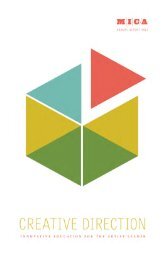art/vision/voice - Maryland Institute College of Art
art/vision/voice - Maryland Institute College of Art
art/vision/voice - Maryland Institute College of Art
You also want an ePaper? Increase the reach of your titles
YUMPU automatically turns print PDFs into web optimized ePapers that Google loves.
114 <strong>art</strong> / <strong>vision</strong> / <strong>voice</strong><br />
Getting St<strong>art</strong>ed<br />
In a “getting acquainted” activity designed for<br />
the first session, each p<strong>art</strong>icipant created a<br />
“coat <strong>of</strong> arms,” and it was attached to his or<br />
her <strong>art</strong> club sketchbook. The case narrative<br />
does not tell how the coat <strong>of</strong> arms was used<br />
intrapersonally. Was each p<strong>art</strong>icipant given<br />
time to talk about what it represented? Did<br />
sharing appear to break the ice or help kids<br />
make connections with one another? Also not<br />
clear is what students where asked to<br />
represent on the coat <strong>of</strong> arms other than the<br />
notion that the project appears to have dealt<br />
with “self-identity.” One wonders if interests<br />
such as sports or other favorite activities or<br />
places might have surfaced, which would have<br />
helped staff gain more personal insight into<br />
club members and help them to know what<br />
kinds <strong>of</strong> projects would interest the<br />
community youth.<br />
The dilemma <strong>of</strong> where to go from this<br />
promising st<strong>art</strong> surfaced immediately after<br />
this initial session. While team leaders<br />
considered projects that involved tactile<br />
media, freedom, and directed instruction in<br />
drawing skills, there is no mention <strong>of</strong> any<br />
consideration <strong>of</strong> themes or subject matter that<br />
might have been <strong>of</strong> interest to the<br />
p<strong>art</strong>icipants. One wonders if the kids were<br />
asked to talk about <strong>art</strong> media they had used<br />
and liked or wanted to try, things they liked to<br />
make, and what their feelings were about<br />
being given some instruction in how to draw.<br />
A questionnaire and/or a group discussion<br />
might have provided more information to use<br />
in planning the initial sequence <strong>of</strong> activities.<br />
Conflicting ideas about the purposes <strong>of</strong> the<br />
<strong>art</strong> club arose among the three leaders. Should<br />
the club be a “craft hour” or use a “fine <strong>art</strong>s<br />
approach” to build drawing skills? In reality,<br />
both notions have merit. It may be that some<br />
<strong>art</strong>ful combination <strong>of</strong> craft and <strong>art</strong> is<br />
necessary to reach a broad range <strong>of</strong> interests.<br />
Projects that ensure early p<strong>art</strong>icipant success<br />
may be essential to building confidence and<br />
helping p<strong>art</strong>icipants discover the joy <strong>of</strong><br />
engaging with <strong>art</strong>-making processes. Once<br />
trust is developed, one can then look for<br />
“teachable moments” to introduce new<br />
representational strategies, such as drawing<br />
from observation. Finding those teachable<br />
moments where students want to know how<br />
to represent an idea requires close attention<br />
to what students are trying to do. Adolescents<br />
may benefit from any number <strong>of</strong><br />
representational strategies, including copying,<br />
working from visual references, learning<br />
narrative techniques, and working from<br />
observation.<br />
The case narrative notes that p<strong>art</strong>icipants<br />
found drawing from life to be intimidating.<br />
However, this should not necessarily be taken<br />
as a sign that kids do not want to know how<br />
to draw from observation. Again, more<br />
information about p<strong>art</strong>icipants’ interests<br />
might have been useful. For some visual and<br />
spatial learners, drawing creates more<br />
problems than for others. How young people<br />
are introduced to and instructed in the use <strong>of</strong><br />
different representational strategies makes a<br />
big difference. P<strong>art</strong>icipants learn best when<br />
their need to express their own ideas,<br />
thoughts, and feelings is addressed.<br />
In reflecting on the experience <strong>of</strong> doing<br />
blind contour drawings, the cap leaders<br />
suggest that the kids did indeed “get it.” Yet,<br />
this observation is qualified by the<br />
observation that the kids did not understand<br />
the success they had achieved. In the narrative,<br />
this omission is explained by a lack <strong>of</strong> time to<br />
discuss the drawings at the end <strong>of</strong> class. While<br />
blind contour drawing is developmentally<br />
appropriate for this age level—as a step<br />
forward in learning to see edges and contours<br />
more accurately—this kind <strong>of</strong> drawing does<br />
not always fulfill preadolescent needs to make
















